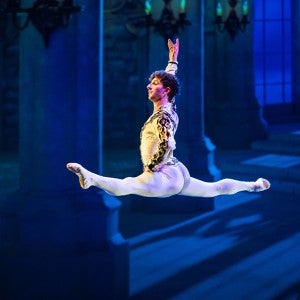Sydney Skybetter choreographs the future
For one dance alumnus, the study of bodies in motion transcends the arts.
Alumnus Sydney Skybetter (IAC 95-98, IAA 99-00) calls himself a choreographer. However, one look at his website lets you know that there’s much more than dance going on in Skybetter’s brain. Take a few minutes, or a few dozen minutes, to click through the pages, videos, and links of his website, and you’ll begin to understand that for Skybetter the definition of “choreographer” has taken on new meaning since his days as a dance major at Interlochen.
In an article about the use of virtual reality in ballet last year, The Financial Times called Skybetter “one of the world’s foremost thinkers on the intersection of dance and emerging technologies.” He’s senior lecturer and associate chair of Theatre Arts & Performance Studies at Brown University, where he founded the Conference for Research on Choreographic Interfaces. His choreography has been performed at such venues as The John F. Kennedy Center for the Performing Arts, Jacob’s Pillow, and The Joyce Theater, and he’s also a sought-after speaker, writer, and consultant on issues of change and technology.
We recently asked Skybetter some questions about his unusual journey from dancer to choreographer to technology thought leader.
What’s your Interlochen story? How did you get here and what difference did it make in your life?
I was a weird art nerd as a kid. I had friends but was constantly bullied. For years, I spent my summers as a dance major at Interlochen Arts Camp and then attended Interlochen Arts Academy. Interlochen, for me, was this Arcadian space where being artistic, sensitive, queer, or creative didn’t make you a target. I was lucky, and intensely privileged, to have access to such a space. It was both transformative and a means of survival.
It also gave me excellent training. The tutelage I received from Sharon Randolph, Mark Borchelt, Erika Randall, Mrs. K, Ms. Gaede, B.J. Sullivan, Wendy Masterson, Kelly Greenfield, Paula Hunter, and Amy Arntsen directly led to the colossally weird art nerd career I’ve enjoyed.
We often think about artists contributing to the world as performers or creators, but you’ve moved beyond those roles. How would you describe yourself now and how did you make that transition?
I describe myself as a choreographer, but the meaning of that word has changed dynamically over time. For many years I performed myself, ran a dance company with my name on it, and received commissions from prestigious places. I was pretty good at it, but the dance field has a cultural expectation that choreographers look like I do: white, able-bodied, and with years and years of elite ballet training. Back then, I thought I succeeded on the basis of my own brilliance. This is, at best, half true. I was talented, sure, but the culture industry has long maintained systems to ensure the success of folks like me.
Once I came to understand my implication in that system, it was difficult to carry on as though the status quo was okay. You can’t just turn off your privilege in systems that perpetuate such things. But given a little agency, you can make choices about how that privilege is wielded and ideally use it for the good of those with less agency than yourself.
Your current work is at the intersection of dance and technology, especially related to robotics and surveillance. What unique perspective do you bring to these fields, which we usually think of as dominated by scientists and engineers?
Choreography is all about how bodies move through space and time to create meaning. While choreography is conventionally understood to be about dancers performing for an audience of people, I’ve found dance to be exceptionally useful when thinking about how our bodies create data for surveillant systems (think Facebook or the Apple Watch) as well as when the bodies in question aren’t human at all (think drones, robots, or avatars in VR). My dance training gives me a rich, critical vocabulary to describe how these things work, while my knowledge of western dance history affords a unique perspective on bodily technologies relative to power and performance.
This means, functionally, that I’m intensely sensitive to how emerging technologies impact our bodies, our flesh, our livelihoods. It’s specifically because I’m not a technologist but have lived my entire career working in and on and through my body that my perspective on such matters is so sensorial. For dancers, one’s body is one’s career. You have to prioritize health and wellness; otherwise, you’ll be out of a job. This perspective of putting bodies first is, most of the time, the *exact opposite* way that technologists work, wherein the things technology can do are prioritized over impacts on users. Everything I do prioritizes the body. My work in tech–to say nothing of producing, writing, public speaking, consulting, and teaching–aims to help others think similarly.
As technology advances and robots can be programmed to mimic human creativity, what impact do you think these advances are having on the arts world, especially dance? Conversely, what impact are artists having on these technological advances?
One of the coolest things about studying dance history is that you can observe how emerging technologies gradually shift the way performance works. For centuries, the western balletic tradition was this thing that happened in the round and on level ground, and then a bunch of Italian engineers reinvent the proscenium stage, and for about a century everybody argues about whether prosceniums make ballet better or worse, but then all the folks doing the arguing die because, well, time, and we’re left with a ton of proscenium stages and ballets that get done on those stages. Whether it’s lighting technologies, or the pointe shoe, or fireproof curtains, or ticketing, or the Internet, dance history is a genealogy of initially emerging technologies that gradually integrate into the art itself. I honestly don’t know how robots or AI will inform the dance of the future. I just know that they will.
There are TONS of dancers and choreographers at work on all of these things: expressive robotics, interfaces for emerging technologies, dance performance in microgravity–I could go on! There is just SO MUCH cool work being done by dancerly folks across all manner of emerging technologies. Their practices illustrate just how useful and meaningful training in dance can be.
Let that be a bit of good news to anyone who wants to study the arts but is concerned they’ll never get a “real job” at the end of it.
Much of your work is done in an interdisciplinary environment. What tools are necessary for the type of collaboration required in your work today? Did you learn any collaboration skills at Interlochen that have been useful?
There’s this mythology of interdisciplinary collaboration that suggests if one is working interdisciplinarily, and if you announce loud enough for others to hear that you’re working collaboratively, then somehow everyone is equal and the work magically exists outside hierarchies of power. It’s one of the things that makes me crazy about arts and technology frameworks like STEM to STEAM: the assumption that, if we collaborate, we can erase the literally hundreds of years of legacy code that says expertise in engineering is more socially valuable than expertise in the arts. I’m all for interdisciplinary collaboration. I do it for a living, and create facilitated structures for others to do the same. But we don’t set anyone up for success, especially not artists, if we ignore how power and bias get reflected in such operations.
At Interlochen, I worked with Mark Borchelt on an independent study centering dance history and criticism. We read extensively about early American modern dance, and how journalists initially struggled to articulate how this new art form functioned, how it communicated, why it was urgent, how it mattered. A lot of this writing was just a colossal mess by contemporary standards, but over years and years a critical vocabulary emerged to document the dance’s ways and means. From this work with Mark, I learned the power, and risk, of naming things.
Meanwhile, interdisciplinary collaboration is all about naming things! It’s chock full of articulating and re-articulating, framing and reframing, until all parties have a sufficiently shared understanding for work to proceed. It’s a super wordy process.
Anyway, apropos my career, I learned how words work from dance class.
What’s your favorite Interlochen memory?
The morning of graduation, I woke up early and found myself walking on the beach by the dance building. The sun was rising, and I sat on a bench, and I watched the water and was just overcome by the noisy silence and total gorgeousity of the moment. I decided on that rickety bench on that cold morning to do whatever I could to lead a life that lived up to the promise of the moment. I wanted to make choices deserving of the beauty and privilege of Interlochen. The result has been a life suffused with art, and a career unlike any I could have dreamed.
Want to learn more about Sydney Skybetter’s work? Check out these links:
- Wired, July 8, 2021, Boston Dynamics, BTS, and Ballet: The Next Act for Robotics
- TEDx Talks: The Choreography of the Internet of Things
- The Conference for Research on Choreographic Interfaces (CRCI








